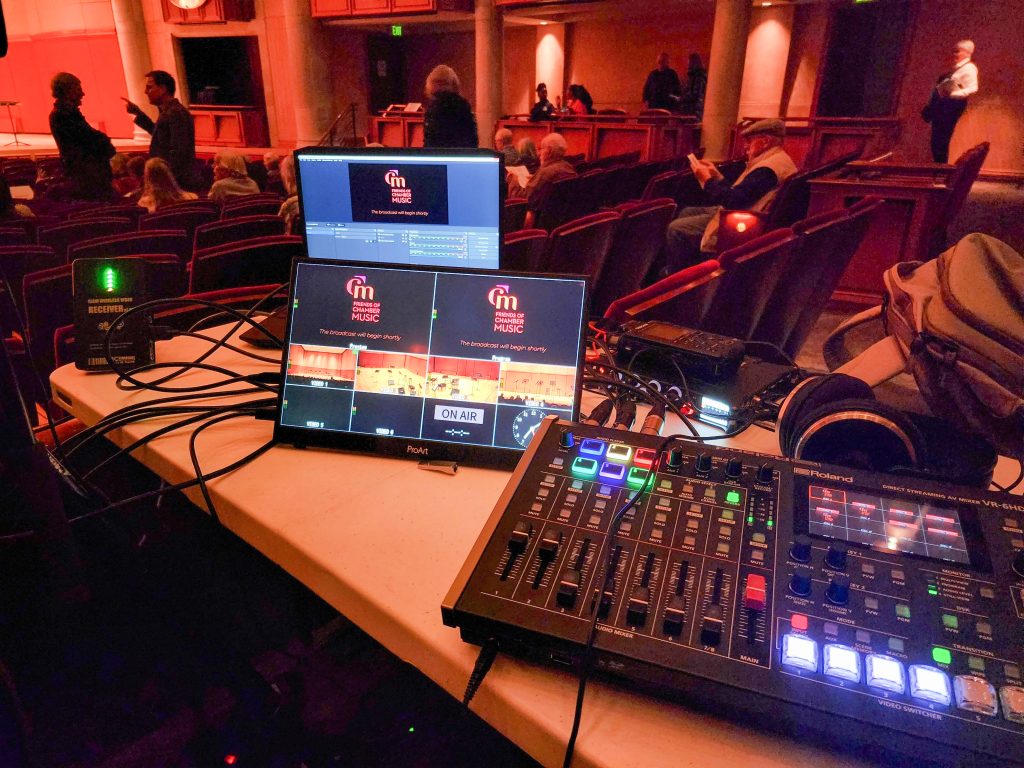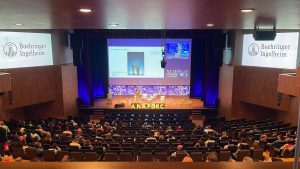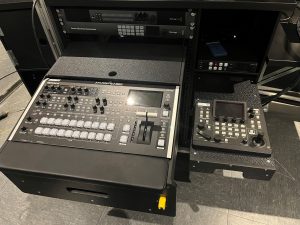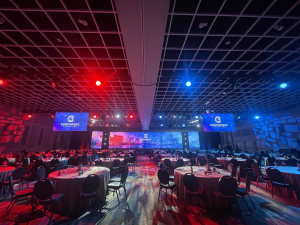- Owen Zhou runs a business capturing orchestral concerts, social media promo videos, and commercial CD releases for Denver's booming classical music community.
- The Roland VR-6HD is essential to his workflow, providing him with a host of features.
- Zhou offers tips for aspiring business owners in the Pro A/V space.
Based in Denver, Colorado, Owen Zhou provides A/V services for orchestras, chamber ensembles, soloists, colleges, and art schools with recording and production through his company Opus Zero. But there’s more to Zhou. He’s an accomplished musician and videographer whose work spans many genres. Zhou gives an in-depth look at his business, offers tips, and reveals why the Roland VR-6HD is essential to his workflow.
Mr. Zhou’s Opus
Tell us about your company, Opus Zero.
Opus Zero is the brand I started with, but as my business grew, my name became the brand. I offer a wide array of audio and video services in the Denver area. These include orchestral concerts, social media promo videos, and commercial CD releases. Some of my clients include the Denver Young Artists Orchestra, Boulder Bach Festival, Friends of Chamber Music, and the University of Colorado at Boulder.
You hold a D.M.A. Piano Performance, an M.M. Piano Performance, and a B.M. Piano Performance. What led you to the world of video and audio production?
I started dabbling in audio recording during my junior year at the Eastman School of Music (2007). My first audio interface was the Roland Edirol FA-66, so I’ve come full circle. The FA-66 was a capable little box with a very industrial design. I still remember the block diagram on top. The impetus for my audio production journey was to learn to record myself for auditions, etc.
As I gained real-world experience, people started hiring me to record their recitals, and things snowballed. I started diving into video production in 2010 when I started my doctorate program at CU Boulder and added livestreaming services in 2020. In hindsight, these two crucial business moves contributed to my success today.
Gear and the VR-6HD
Describe your current A/V setup and how the Roland VR-6HD fits.
Before owning the VR-6HD, I used the Atem Mini Pro with the ZEDi-10FX analog mixer. For my livestreaming clients, audio quality is paramount, so I need mixing capabilities on the front end, which is why I was using the mixer.
The Roland VR-6HD piqued my interest because it has a robust audio mixer and six HDMI inputs versus the four inputs on the Atem. The VR-6HD is the perfect all-in-one solution for me and my clients. Instead of hauling around a separate audio mixer, the VR-6HD can do it all.
The Roland VR-6HD remains one of the best investments I have made for my business—a true all-in-one solution for my livestreaming work. One word to describe the VR-6HD is superlative.
The Roland VR-6HD remains one of the best investments I have made for my business—a true all-in-one solution for my livestreaming work. One word to describe the VR-6HD is superlative.
Owen Zhou
Challenges and Discoveries
What specific challenges in your business does the VR-6HD help you solve?
For a typical streaming setup, I will have microphones onstage for recording. Clients often request mixed/processed audio after the concert. The microphones will feed into my MixPre 10 II audio recorder. The MixPre 10 has a multitude of output options. It will feed a backup recorder and a stereo mix into the VR-6HD for streaming.
This is where the well-rounded audio capabilities of the VR-6HD come in handy. I will apply a parametric EQ and reverb on the master bus for a more polished sound, as I would for audio post-production. On the video side, I have between three and five cameras connected for streaming. I also use a portable monitor connected to HDMI Out 3 for multiview monitoring. I will set the built-in monitor on the VR-6HD to audio meters. This covers all my monitoring needs while live.
Currently, I only use the VR-6HD for streaming concerts, primarily classical music, choral, and dance. I haven’t used it with other types of events yet.

Have you discovered any special tricks using the VR-6HD that you’d like to share?
To preface these, I’m usually the type that will eventually read the manual. Still, I typically like to start by exploring the user interface myself and see what I can figure out intuitively. The VR-6HD has one of the most intuitive interfaces I’ve ever used. Things make sense, and the touchscreen buttons are large and responsive.
My first major discovery came when streaming with cameras via HDMI. Most cameras will have a delay on the HDMI output, which one must compensate for on the audio end by delaying the audio to match the HDMI signal. My Atem had this ability, but you can only set it to frames, which doesn’t offer the finest gradient. The VR-6HD can adjust the audio delay down to milliseconds.
So while I was turning the knob on the VR-6HD to adjust my audio delay, I needed the delay to be around 440 ms. It was taking a long time since each click of the encoder knob is only 1 ms. Then I thought, “What if I turn the encoder while pressing it down?” It started changing the value by increments of ten. My mind was blown.
Most cameras will have a delay on the HDMI output, which one must compensate for on the audio end by delaying the audio to match the HDMI signal. The VR-6HD can adjust the audio delay down to milliseconds.
Owen Zhou
My next discovery after the previous one is still related to audio delay. When I’m streaming, I usually monitor the audio via headphones. But the audio in my headphones has to be real-time and not delayed because I’m sitting in the hall and hearing the live stage sound.
If my headphone audio gets delayed that is disorienting. With that in mind, I looked to see the options under the master bus Setup button. I saw a separate USB Stream and learned I could delay just the USB stream bus, independent of the main audio bus I’m monitoring through my headphones. I can monitor effects in real time while the audio sent to my laptop/OBS is properly delayed, solving a monitoring headache.
Are there any other features of the VR-6HD that are particularly useful?
I use the Still Images section for intro/intermission graphics and the Downstream Keyer for subtitles/lower thirds. I appreciate having audio processing capabilities on each input channel and the main audio bus, especially having both graphic and parametric EQ on the main audio bus.
Classical Colorado
What makes Colorado a hub for classical music?
The classical music scene in and around Denver is a thriving community, which I attribute to multiple factors. First, Colorado is home to numerous high-caliber music schools. This solidifies the classical scene by providing a stream of highly qualified musicians to different organizations and orchestras.
A few organizations I work with include people I went to school with at CU Boulder. The result of high-quality music education is evident in another client of mine, the Denver Young Artists Orchestra. Their performances captivate the audience with their maturity and finesse.
Another client, Friends of Chamber Music, is known for signing A-listers and bringing them to Denver. Andras Schiff, Jeremy Denk, and Beatrice Rana were some of the preeminent pianists who appeared in the Friends of Chamber Music series in recent years. The audience is also enthusiastic, creating a perfect balance of supply and demand.
Professional Advice
What advice do you have for aspiring videographers who are starting to build a client base?
Being in the business for over a decade, I have a few principles folks can follow when they are just starting. These are in no particular order.
- The only way to improve your craft is through experience. Debrief after each gig, and think about what went well and what could be improved.
- Don’t be discouraged. You will mess up at some point. Keep going, but do the right thing for your client by offering discounted or free services.
- Listen to your clients and their needs and help them realize their vision. If two people have similar skill sets but one is easier to work with, clients will pick that person every time.
- Develop a workflow that works for you. When projects pile up, you have to be able to get through them quickly and efficiently.
- Develop a file management system. I’ve had clients reach out years later requesting their files; you have to be able to pull those files upon request.
- Be steadfast. Business takes time to build. I focused on each client and gave each gig 100%, and my list grew steadily. Remember why you started this job? It can be fun, and you provide important services to clients.
The only way to improve your craft is through experience. Debrief after each gig, and think about what went well and what could be improved.
Owen Zhou
What is on the horizon for you?
I am continuing to build on what I already have built. CU Boulder’s College of Music contracted me as a freelancer videographer/photographer this year, pushing my boundaries in the best way possible. I’m diving into interview shoots, headshots, and event photography. But my core business is still music recording and concert videography/streaming.



